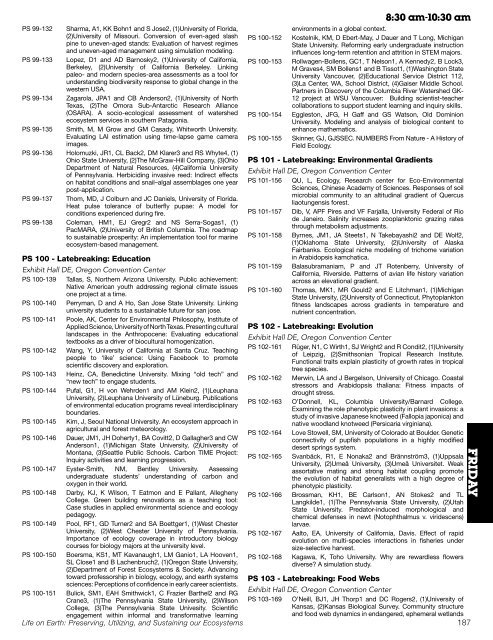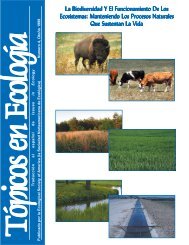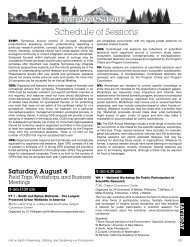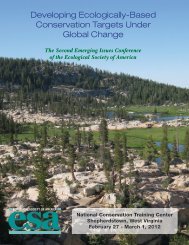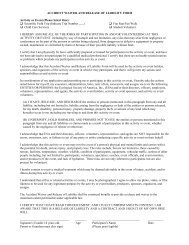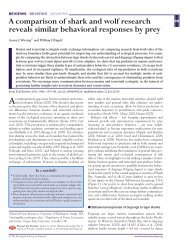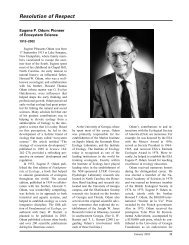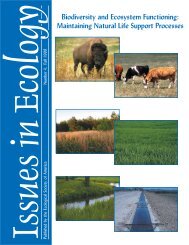Printed Program (PDF) - Ecological Society of America
Printed Program (PDF) - Ecological Society of America
Printed Program (PDF) - Ecological Society of America
Create successful ePaper yourself
Turn your PDF publications into a flip-book with our unique Google optimized e-Paper software.
PS 99-132 Sharma, A1, KK Bohn1 and S Jose2, (1)University <strong>of</strong> Florida,<br />
(2)University <strong>of</strong> Missouri. Conversion <strong>of</strong> even-aged slash<br />
pine to uneven-aged stands: Evaluation <strong>of</strong> harvest regimes<br />
and uneven-aged management using simulation modeling.<br />
PS 99-133 Lopez, D1 and AD Barnosky2, (1)University <strong>of</strong> California,<br />
Berkeley, (2)University <strong>of</strong> California Berkeley. Linking<br />
paleo- and modern species-area assessments as a tool for<br />
understanding biodiversity response to global change in the<br />
western USA.<br />
PS 99-134 Zagarola, JPA1 and CB Anderson2, (1)University <strong>of</strong> North<br />
Texas, (2)The Omora Sub-Antarctic Research Alliance<br />
(OSARA). A socio-ecological assessment <strong>of</strong> watershed<br />
ecosystem services in southern Patagonia.<br />
PS 99-135 Smith, M, M Grow and GM Casady, Whitworth University.<br />
Evaluating LAI estimation using time-lapse game camera<br />
images.<br />
PS 99-136 Holomuzki, JR1, CL Back2, DM Klarer3 and RS Whyte4, (1)<br />
Ohio State University, (2)The McGraw-Hill Company, (3)Ohio<br />
Department <strong>of</strong> Natural Resources, (4)California University<br />
<strong>of</strong> Pennsylvania. Herbiciding invasive reed: Indirect effects<br />
on habitat conditions and snail–algal assemblages one year<br />
post-application.<br />
PS 99-137 Thom, MD, J Colburn and JC Daniels, University <strong>of</strong> Florida.<br />
Heat pulse tolerance <strong>of</strong> butterfly pupae: A model for<br />
conditions experienced during fire.<br />
PS 99-138 Coleman, HM1, EJ Gregr2 and NS Serra-Sogas1, (1)<br />
PacMARA, (2)University <strong>of</strong> British Columbia. The roadmap<br />
to sustainable prosperity: An implementation tool for marine<br />
ecosystem-based management.<br />
8:30 am-10:30 am<br />
environments in a global context.<br />
PS 100-152 Kostelnik, KM, D Ebert-May, J Dauer and T Long, Michigan<br />
State University. Reforming early undergraduate instruction<br />
influences long-term retention and attrition in STEM majors.<br />
PS 100-153 Rollwagen-Bollens, GC1, T Nelson1, A Kennedy2, B Lock3,<br />
M Graves4, SM Bollens1 and B Tissot1, (1)Washington State<br />
University Vancouver, (2)Educational Service District 112,<br />
(3)La Center, WA, School District, (4)Gaiser Middle School.<br />
Partners in Discovery <strong>of</strong> the Columbia River Watershed GK-<br />
12 project at WSU Vancouver: Building scientist-teacher<br />
collaborations to support student learning and inquiry skills.<br />
PS 100-154 Eggleston, JFG, H Gaff and GS Watson, Old Dominion<br />
University. Modeling and analysis <strong>of</strong> biological content to<br />
enhance mathematics.<br />
PS 100-155 Skinner, GJ, GJSSEC. NUMBERS From Nature - A History <strong>of</strong><br />
Field Ecology.<br />
PS 101 - Latebreaking: Environmental Gradients<br />
Exhibit Hall DE, Oregon Convention Center<br />
PS 101-156 QU, L, Ecology, Research center for Eco-Environmental<br />
Sciences, Chinese Academy <strong>of</strong> Sciences. Responses <strong>of</strong> soil<br />
microbial community to an altitudinal gradient <strong>of</strong> Quercus<br />
liaotungensis forest.<br />
PS 101-157 Dib, V, APF Pires and VF Farjalla, University Federal <strong>of</strong> Rio<br />
de Janeiro. Salinity increases zooplanktonic grazing rates<br />
through metabolism adjustments.<br />
PS 101-158 Byrnes, JM1, JA Steets1, N Takebayashi2 and DE Wolf2,<br />
(1)Oklahoma State University, (2)University <strong>of</strong> Alaska<br />
Fairbanks. <strong>Ecological</strong> niche modeling <strong>of</strong> trichome variation<br />
PS 100 - Latebreaking: Education<br />
in Arabidopsis kamchatica.<br />
Exhibit Hall DE, Oregon Convention Center<br />
PS 100-139 Tallas, S, Northern Arizona University. Public achievement:<br />
Native <strong>America</strong>n youth addressing regional climate issues<br />
one project at a time.<br />
PS 100-140 Perryman, D and A Ho, San Jose State University. Linking<br />
university students to a sustainable future for san jose.<br />
PS 101-159<br />
PS 101-160<br />
Balasubramaniam, P and JT Rotenberry, University <strong>of</strong><br />
California, Riverside. Patterns <strong>of</strong> avian life history variation<br />
across an elevational gradient.<br />
Thomas, MK1, MR Gould2 and E Litchman1, (1)Michigan<br />
State University, (2)University <strong>of</strong> Connecticut. Phytoplankton<br />
fitness landscapes across gradients in temperature and<br />
nutrient concentration.<br />
PS 100-141 Poole, AK, Center for Environmental Philosophy, Institute <strong>of</strong><br />
Applied Science, University <strong>of</strong> North Texas. Presenting cultural PS 102 - Latebreaking: Evolution<br />
PS 100-142<br />
PS 100-143<br />
PS 100-144<br />
PS 100-145<br />
PS 100-146<br />
PS 100-147<br />
landscapes in the Anthropocene: Evaluating educational<br />
textbooks as a driver <strong>of</strong> biocultural homogenization.<br />
Wang, Y, University <strong>of</strong> California at Santa Cruz. Teaching<br />
people to ‘like’ science: Using Facebook to promote<br />
scientific discovery and exploration.<br />
Heinz, CA, Benedictine University. Mixing “old tech” and<br />
“new tech” to engage students.<br />
Pufal, G1, H von Wehrden1 and AM Klein2, (1)Leuphana<br />
University, (2)Leuphana University <strong>of</strong> Lüneburg. Publications<br />
<strong>of</strong> environmental education programs reveal interdisciplinary<br />
boundaries.<br />
Kim, J, Seoul National University. An ecosystem approach in<br />
agricultural and forest meteorology.<br />
Dauer, JM1, JH Doherty1, BA Covitt2, D Gallagher3 and CW<br />
Anderson1, (1)Michigan State University, (2)University <strong>of</strong><br />
Montana, (3)Seattle Public Schools. Carbon TIME Project:<br />
Inquiry activities and learning progression.<br />
Eyster-Smith, NM, Bentley University. Assessing<br />
undergraduate students’ understanding <strong>of</strong> carbon and<br />
oxygen in their world.<br />
Exhibit Hall DE, Oregon Convention Center<br />
PS 102-161 Rüger, N1, C Wirth1, SJ Wright2 and R Condit2, (1)University<br />
<strong>of</strong> Leipzig, (2)Smithsonian Tropical Research Institute.<br />
Functional traits explain plasticity <strong>of</strong> growth rates in tropical<br />
tree species.<br />
PS 102-162 Merwin, LA and J Bergelson, University <strong>of</strong> Chicago. Coastal<br />
stressors and Arabidopsis thaliana: Fitness impacts <strong>of</strong><br />
drought stress.<br />
PS 102-163 O’Donnell, KL, Columbia University/Barnard College.<br />
Examining the role phenotypic plasticity in plant invasions: a<br />
study <strong>of</strong> invasive Japanese knotweed (Fallopia japonica) and<br />
native woodland knotweed (Persicaria virginiana).<br />
PS 102-164 Love Stowell, SM, University <strong>of</strong> Colorado at Boulder. Genetic<br />
connectivity <strong>of</strong> pupfish populations in a highly modified<br />
desert springs system.<br />
PS 102-165 Svanbäck, R1, E Nonaka2 and Brännström3, (1)Uppsala<br />
University, (2)Umeå University, (3)Umeå Universitet. Weak<br />
assortative mating and strong habitat coupling promote<br />
the evolution <strong>of</strong> habitat generalists with a high degree <strong>of</strong><br />
phenotypic plasticity.<br />
PS 100-148 Darby, KJ, K Wilson, T Eatmon and E Pallant, Allegheny<br />
College. Green building renovations as a teaching tool:<br />
Case studies in applied environmental science and ecology<br />
pedagogy.<br />
PS 102-166 Brossman, KH1, BE Carlson1, AN Stokes2 and TL<br />
Langkilde1, (1)The Pennsylvania State University, (2)Utah<br />
State University. Predator-induced morphological and<br />
chemical defenses in newt (Notophthalmus v. viridescens)<br />
PS 100-149 Pool, RF1, GD Turner2 and SA Boettger1, (1)West Chester<br />
larvae.<br />
University, (2)West Chester University <strong>of</strong> Pennsylvania.<br />
Importance <strong>of</strong> ecology coverage in introductory biology<br />
courses for biology majors at the university level.<br />
PS 102-167 Aalto, EA, University <strong>of</strong> California, Davis. Effect <strong>of</strong> rapid<br />
evolution on multi-species interactions in fisheries under<br />
size-selective harvest.<br />
PS 100-150 Boersma, KS1, MT Kavanaugh1, LM Ganio1, LA Hooven1,<br />
SL Close1 and B Lachenbruch2, (1)Oregon State University,<br />
(2)Department <strong>of</strong> Forest Ecosystems & <strong>Society</strong>. Advancing<br />
PS 102-168 Kagawa, K, Toho University. Why are rewardless flowers<br />
diverse? A simulation study.<br />
toward pr<strong>of</strong>essorship in biology, ecology, and earth systems<br />
sciences: Perceptions <strong>of</strong> confidence in early career scientists.<br />
PS 100-151 Bulick, SM1, EAH Smithwick1, C Frazier Barthel2 and RG<br />
Crane3, (1)The Pennsylvania State University, (2)Wilson<br />
College, (3)The Pennsylvania State Univesity. Scientific<br />
engagement within informal and transformative learning<br />
Life on Earth: Preserving, Utilizing, and Sustaining our Ecosystems<br />
PS 103 - Latebreaking: Food Webs<br />
Exhibit Hall DE, Oregon Convention Center<br />
PS 103-169 O’Neill, BJ1, JH Thorp1 and DC Rogers2, (1)University <strong>of</strong><br />
Kansas, (2)Kansas Biological Survey. Community structure<br />
and food web dynamics in endangered, ephemeral wetlands<br />
187<br />
FRIDAY


